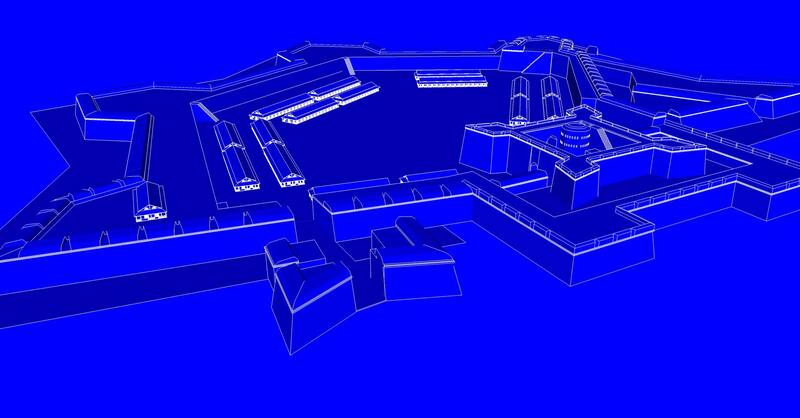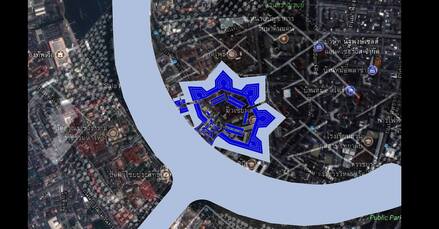Bangkok-Fortification East side
Sawitree Premkamon
In collaboration with Baan Noorg Collaborative Arts and Culture
Sawitree Premkamol, born in 1991, lives and works in Nonthaburi, received her BA from Computer Aided Design and Construction Management, Technology and Industrial Management Faculty, King Mongkut University Technology North of Bangkok. During 2013-2016, she was assistant architect at the Quality House Co., Ltd. In the Bangkok Layers project, with her major area, architecture, construction management, graphic and multimedia programming, Sawitree studied and made in depth research – investigated, integrated and analyzed scattered information as of the eastern Vauban architecture structure, place and space that became vague with time, re-emerged the dimension of this geographical architecture. It reveals the connection between design concept of architecture, civil engineering, town planning, social organization in parallel with new art of fortification and modern military strategy in relating interdisciplinary technological war, military and security, economics-politics and resource management. The concept of the construction was made through foundation piles to absorb destructive impacts from the use of gunpowder and metal cannon-balls weapons. Its pentagonal bastions under the modern military concept of an absolutist government was designed and initiated by Sebastien Le Prestre de Vauban (b. 1633-1707) who was an architect, engineer, a significant French militarian during 17th century. The Vauban’s fortification concept played significant role in the history of fortification. It had been military’s standard building system that spread all over the world including America and Asia continents. The UNESCO had identified a number of Vauban’s fortresses as the world heritage.
The Vauban’s fortification concept and construction method reached Siam through the ambassador Chevalier de Chaumont’s visit which established ties with Ayutthaya kingdom in 1685. King Narai had requested Chevalier de Forbin to serve the kingdom and in charge as a commander to expand the fortress construction to meet European standard and to act as a French army military base of French armies. The Vauban’s fortification plan was permitted to be built on the east side of the Chao Phraya River under the engineering design of Sieur De La Mare’s supervision. Chevalier de Forbin was appointed as Ok Phra Sakdi Songkhram or grand admiral, governor of Bangkok and General of Siamese army and navy to train the armies and to administer the military system with European standard at the Bangkok fortress. The fortified building on the east was firstly built during 1687-88 within a huge area that can be referred to the present landscape from the north side at Tien pier (Tha Tien) towards Phra Chetuphon temple to the south at Rajini school, the MRT’s Sanam Chai station until Wat Ratchabophit school and Museum Siam on the west and reaches the Chao Phraya River on the east.
During 1688, there were 2 battles on the east side of the fortress of Bangkok. One of the incidents was the Makassar rebels and Siamese troops besieged the French armies by Phra Phetracha, the usurper. The siege took over 6-month period but it was not succeeded to takeover the fortress. It ended with an armistice and the French troops were allowed to leave Siam in November 1688. The east fortress was later demolished during the early period of the constitution of Ratttanakosin kingdom while the palace was built in 1782.
Sawitree Premkamon
Bangkok-Fortification East side, 2018
2 channel monitors full HD video, color, silent, 4 min 9 sec, loop
In collaboration with Baan Noorg Collaborative Arts and Culture
Sawitree Premkamon
In collaboration with Baan Noorg Collaborative Arts and Culture
Sawitree Premkamol, born in 1991, lives and works in Nonthaburi, received her BA from Computer Aided Design and Construction Management, Technology and Industrial Management Faculty, King Mongkut University Technology North of Bangkok. During 2013-2016, she was assistant architect at the Quality House Co., Ltd. In the Bangkok Layers project, with her major area, architecture, construction management, graphic and multimedia programming, Sawitree studied and made in depth research – investigated, integrated and analyzed scattered information as of the eastern Vauban architecture structure, place and space that became vague with time, re-emerged the dimension of this geographical architecture. It reveals the connection between design concept of architecture, civil engineering, town planning, social organization in parallel with new art of fortification and modern military strategy in relating interdisciplinary technological war, military and security, economics-politics and resource management. The concept of the construction was made through foundation piles to absorb destructive impacts from the use of gunpowder and metal cannon-balls weapons. Its pentagonal bastions under the modern military concept of an absolutist government was designed and initiated by Sebastien Le Prestre de Vauban (b. 1633-1707) who was an architect, engineer, a significant French militarian during 17th century. The Vauban’s fortification concept played significant role in the history of fortification. It had been military’s standard building system that spread all over the world including America and Asia continents. The UNESCO had identified a number of Vauban’s fortresses as the world heritage.
The Vauban’s fortification concept and construction method reached Siam through the ambassador Chevalier de Chaumont’s visit which established ties with Ayutthaya kingdom in 1685. King Narai had requested Chevalier de Forbin to serve the kingdom and in charge as a commander to expand the fortress construction to meet European standard and to act as a French army military base of French armies. The Vauban’s fortification plan was permitted to be built on the east side of the Chao Phraya River under the engineering design of Sieur De La Mare’s supervision. Chevalier de Forbin was appointed as Ok Phra Sakdi Songkhram or grand admiral, governor of Bangkok and General of Siamese army and navy to train the armies and to administer the military system with European standard at the Bangkok fortress. The fortified building on the east was firstly built during 1687-88 within a huge area that can be referred to the present landscape from the north side at Tien pier (Tha Tien) towards Phra Chetuphon temple to the south at Rajini school, the MRT’s Sanam Chai station until Wat Ratchabophit school and Museum Siam on the west and reaches the Chao Phraya River on the east.
During 1688, there were 2 battles on the east side of the fortress of Bangkok. One of the incidents was the Makassar rebels and Siamese troops besieged the French armies by Phra Phetracha, the usurper. The siege took over 6-month period but it was not succeeded to takeover the fortress. It ended with an armistice and the French troops were allowed to leave Siam in November 1688. The east fortress was later demolished during the early period of the constitution of Ratttanakosin kingdom while the palace was built in 1782.
Sawitree Premkamon
Bangkok-Fortification East side, 2018
2 channel monitors full HD video, color, silent, 4 min 9 sec, loop
In collaboration with Baan Noorg Collaborative Arts and Culture





